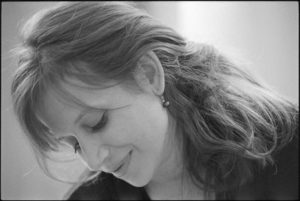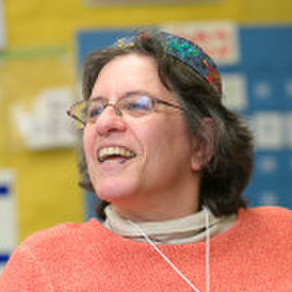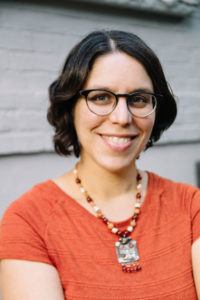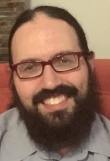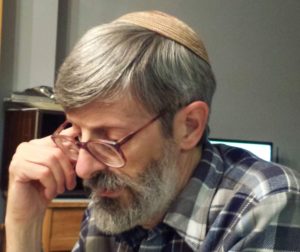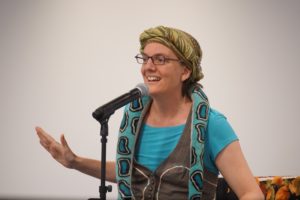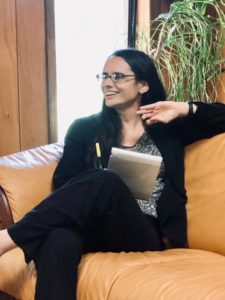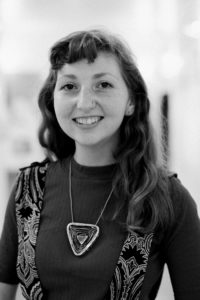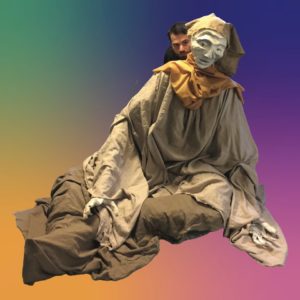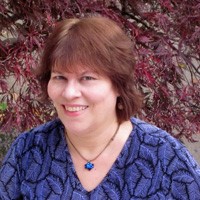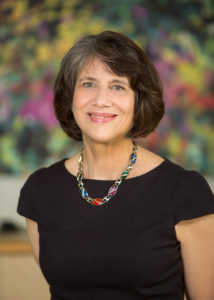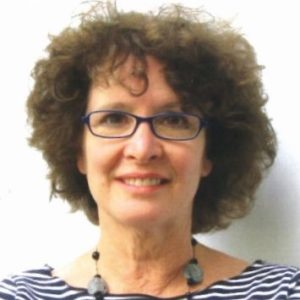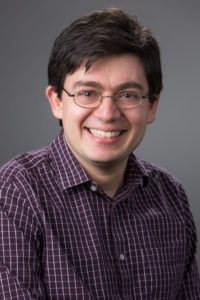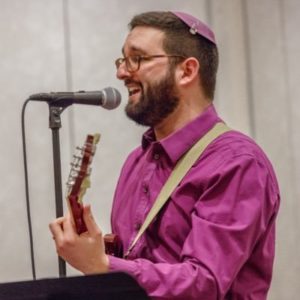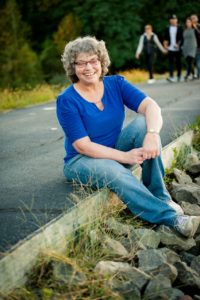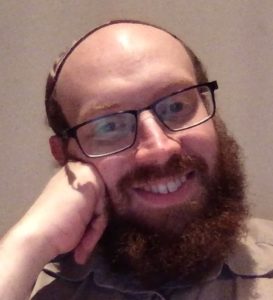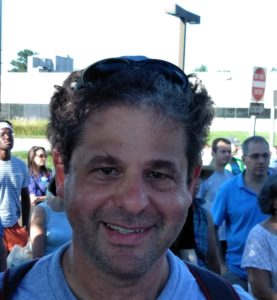Courses meet Monday through Friday for 1 – 1.5 hour sessions.
NOTE ABOUT TISHA B’AV: During the 2020 Institute, Thursday will be Tisha B’Av, a day of mourning for the destruction of the Temple and other tragedies. Some community members will be fasting for the day and/or refraining from Torah study, listening to music, and other joyous activities. The notes below each course description aim to help participants know which options align with their personal practices, not to describe the plan for Thursday’s session fully. If you require additional specific information, an email to office@havurah.org can be forwarded to the teacher. If you do not have a personal Tisha B’Av practice, that requires this information, no need to concern yourself with these notes!
AM-1 (EF): Eating the Bible, Writing the Table, Marcela Sulak, Timbrel Artist in Residence
This course offers writing workshops based on four Biblical texts in which food plays a major narrative role. We will write using prompts based on agricultural practices and food preparation. As additional dimensions to the creative process, we will also prepare food and discuss home gardening design.
- Arts, Music, Performance
- Contemporary Issues
- History and Culture
- Religious Life and Spirituality
- Text Study for Everyone
Tisha B’Av: Exercises will not include eating. Biblical texts will focus on scarcity.
Marcela Sulak is the author of the memoir Mouth Full of Seeds (2020) and the poetry collections City of Sky Papers (forthcoming 2021), Decency (2015), Immigrant (2010)—all from Black Lawrence Press. She’s co-edited Family Resemblance: An Anthology and Exploration of 8 Hybrid Literary Genres and translated four poetry collections from Czech, French, and, most recently, Hebrew. Her work was long listed for the 2017 PEN Award for Poetry Translation and was awarded a 2018 NEA Translation Fellowship. Sulak is associate professor of Literature at Bar-Ilan University; she hosts the radio podcast “Israel in Translation” and edits The Ilanot Review.
AM-2: Oh the Places You’ll Go! The Book of Daniel, Aliza C.P. Arzt
The book of Daniel is rarely studied, partly due to the fact that half of it is in Aramaic. We will look at texts from the book of Daniel through a variety of different lenses including fairy tales, other Biblical stories, history, prophecy, Shabbat z’mirot (songs), and language (Aramaic) learning. Daniel is set in a time of great upheaval for the Jewish people and was actually written in a different time of great upheaval. Together we will learn how those from both times coped with the events of their present, past and future and we’ll also learn a little Aramaic together. The final session will include an opportunity to learn how the Aramaic in Daniel works, which will be more accessible to those with some knowledge of Hebrew.
- Intermediate Text Study
- Suited for Teens
Tisha B’Av: Biblical text study about the destruction of the Temple, Daniel Chapter 5 about Belshazzar’s banquet and “writing on the wall,” and discussion of apocalyptic prophecy.
Aliza Arzt is a home care speech therapist and long time member of Havurat Shalom in Somerville, MA. In addition to caring for a gecko population, working with clay and practicing aikido, she greatly enjoys taking biblical texts apart and putting them back together with other texts to create new connections that walk the line between P’shat (simple meaning) and D’rash (interpretation).
AM-3: Musical Bodies, Musical Souls, Jesse A. Beller
This course will use group singing as a vehicle to explore our relationships to ourselves and to one another. Singing is an opportunity to feel our own presence, to make our presence felt to other people, and to feel the presence of other people, deepening and intensifying the sense of our shared humanity. We will direct our attention both inward, to examine how we use our bodies and our breath as musical instruments to create sounds, and outward, to consider the relationships we build by singing together with others. We will also consider some basic music theory and technique so that we can grow as singers and as musicians, as participants and as leaders in musical communities. This is a group singing class, with a goal of building musical skills in the Havurah community.
- Arts, Music, Performance
- Meditation and Movement
Tisha B’Av: Music, singing, and mindfulness.
Jesse is an avid singer and song leader with a focus on Jewish liturgical music, Anglophone folk songs, and a passion for participatory group singing. Jesse is interested in creating communal spaces where all participants are empowered and lifted up, and he thinks group singing can be a powerful way to do that. Jesse lives in Washington DC with his partner Nava.
AM-4: Rise Up and Stay in the Struggle: Cultivating Our Resilience, Sarah D. Beller
Making a positive difference in times of upheaval can be tough work. All of us who are engaged in safeguarding the dignity of communities and the wellbeing of our planet sometimes encounter situations that make us feel demoralized, frustrated, or burnt out. How can we harness mind, body, and spirit to increase our capacity to rise up (kumi), hang in there, and continue our work for good? In this course, we’ll explore Jewish understandings of resilience and experience hands-on practices to access and expand our inner resilience. Bring an adventurous spirit, as we get “out of our heads” and deeper into our somatic beings (aka bodies) to find the resources we need to make our greatest contributions yet. Participants will come away with a physical reminder of their personal intentions (kavanot) around resilience going forward.
- Contemporary Issues
- Meditation and Movement
- Suited for Teens
Tisha B’Av: Texts from modern Jewish history.
Sarah Beller is a coach, facilitator, entrepreneur, and musician who inspires and empowers people to bring about a more just and thriving world. After a decade building movements to address pressing global issues like the refugee crisis and the Israeli-Palestinian conflict, Sarah launched her own venture. Through Realize Change, Sarah supports women and non-binary folks who want to find fulfilling next steps in their careers and unleash their visions for social change. A trained facilitator and coach, Sarah is a recipient of Avodah’s Partners in Justice award. This will be her 20th consecutive NHC Summer Institute.
AM-5 (EF): To Bigotry No Sanction: George Washington, Touro Synagogue and Us, Shahar Decassares Colt
(This class is Extended Format, covering the morning course AND workshop time slots.)
(This class is Extended Format, covering the morning course AND workshop time slots.)
George Washington famously wrote to the Jewish community of Newport, Rhode Island: “The government of the United States gives to bigotry no sanction, to persecution no assistance.” In this course, we will explore the history of this statement and its meaning for those Newport Jews and other Americans. Then we will shift our attention to reflecting on what these words and history mean to us in our contemporary moment as Jews in America. These conversations will lead to our creating a multi-media “museum exhibit” to share with the Institute community about the meaning of George Washington’s statement in our current moment.
- Arts, Music, Performance
- Contemporary Issues
- History and Culture
Tisha B’Av: Exploration of communal history and relationship to Judaism.
Shahar Colt is a rabbi educator in the Boston area. She has taught Jewish (and not Jewish) content to people of all ages, and she is excited to return as a teacher to the 2020 Havurah Institute.
AM-06: Fasts, Benjamin William Dreyfus
The 2020 Institute will include Tisha B’Av, when many people at Institute and beyond will be fasting, as the day commemorates catastrophic events in Jewish history. This course explores Jewish communal fast days through biblical and rabbinic texts. We’ll explore the roots of Tisha B’Av and the other annual fasts that mourn historical tragedies. But public fasts used to be called for other purposes too: to cry out to God and stir the people to repentance in the face of impending danger such as drought, disease, locusts, and invading armies. What do the texts tell us about the reasons for and the goals of fasting? What are the similarities and differences between the various types of fasts? What are the circumstances in which fasts are held as normal, and when are they delayed or abolished? And what does all of this mean to us now? As we go into and out of Tisha B’Av, we will try to make sense of all these texts together. (Yom Kippur is the best-known Jewish fast day, but this course will focus instead on other fasts, both annual and ad hoc.)
- Religious Life and Spirituality
- Text Study for Everyone
- Suited for Teens
Tisha B’Av: Torah study directly related to Tisha B’Av.
Ben Dreyfus teaches physics at George Mason University in northern Virginia, and helps organize Minyan Segulah on the DC/Maryland border. This is his 16th Institute.
AM-7: Why Does the Torah Make Cows Kosher and Pigs Traif? — Ta’amei HaMitzvot (Rationales for Mitzvot), Richard Friedman
The Torah, in Leviticus 11, presents rules for which species of animals are kosher. In most cases, it’s clear which animals are kosher and which are non-kosher. What’s not clear is why these animals are kosher and those are not. Jewish thinkers and commentators throughout the ages have addressed the issue of ta’amei hamitzvot (rationales for the mitzvot), in general and with respect to particular commandments. We will study rationales that have been proposed for the Torah’s prohibition on eating animals of certain species. We’ll look at a historical range of explanations, including Rambam, Abarbanel, S.R. Hirsch, Mordecai Kaplan, S’fat Emet, and contemporary anthropologists. We’ll study in havruta pairs and then in group discussion.
- Religious Life and Spirituality
- Intermediate Text Study
- Suited for Teens
Tisha B’Av: Study of secular anthropologists’ approaches.
Richard Friedman is a lawyer with the federal government. He has taught numerous times at the NHC Summer Institute, classes including halachic sources on war, the S’fat Emet, and translating the siddur. He teaches weekly classes at his shul on Torah commentary and on Talmud.
AM-8: Telling and Receiving Unsettling Stories, by way of Shavuot’s Bitter Herbs, Andrea Kamens
The two central texts for the holiday of Shavuot, though commonly considered written books, are beautiful examples of the centrality of authentic oral storytelling in Judaism. The balance of the two gives us a model for how we can tell and listen as a holy and celebratory act, individually and in community. In this course, we will examine the statement made by Naomi at the border in the Book of Ruth and the Shavuot script given to us by Moshe, in the name of G-d, in Deuteronomy, and consider how stories are framed, performed, and received. Then we will actively learn about and practice the art of storytelling through storytelling games, working in chevruta pairs as tellers and listeners, and developing a short personal immigration or change of status story, choosing either first-person or traditional forms. There is no storytelling without listening, so be prepared to learn and practice deep listening to create a safe open community for everyone’s stories.
- Arts, Music, Performance
- History and Culture
- Text Study for Everyone
- Suited for Teens
Tisha B’Av: Claiming space, telling and receiving difficult stories (no Torah study or music).
Andrea Kamens tells traditional, original, Jewish, and first-person stories that tremble with truth. With skillful structuring and improvisational verve, she opens a dialogue between her listeners and the story. Based in Boston, MA, she’s on the board of The Story Space in Somerville, the region’s longest running weekly storytelling venue, is a slam teller, emcee, and host, a religious school teacher, a community volunteer and a mom of five who spends her summers seeking the perfect strawberry. Andrea is a graduate of Boston University and spent a year at Shearim College of Jewish Studies in Har Nof, Israel.
AM-9: Interfaith Understanding: How Do We, as Jews, Think about Other Religions?, Larry Moss
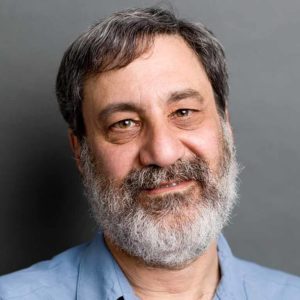 Pluralism is the view that differing theories might all have valid claims; religious pluralism validates the varied claims of different religions. For liberal Jews, it’s a truism that this type of interreligious pluralism is a good thing. But why is this so? Is it basically shalom bayit (keeping the peace) or is there something deeper going on? And just how far does pluralism extend? When one digs a little, there are diverging ways to think about what pluralism even means in the first place. How does this change our perspective? This class will examine issues pertaining to difference based on readings from a wide variety of sources: the Tower of Babel passage in Genesis, its (mis)understanding by Jacques Derrida; Jonathan Sacks; and contemporary Islamic thinker A. Rasheid Omar. These sources will be presented in confrontation, so that each of us can craft our own views in response. For Jews, the issue of religious pluralism was tied to our acceptance by the Western world. Facing fundamentalism, it may mean something different. What does it mean to us today?
Pluralism is the view that differing theories might all have valid claims; religious pluralism validates the varied claims of different religions. For liberal Jews, it’s a truism that this type of interreligious pluralism is a good thing. But why is this so? Is it basically shalom bayit (keeping the peace) or is there something deeper going on? And just how far does pluralism extend? When one digs a little, there are diverging ways to think about what pluralism even means in the first place. How does this change our perspective? This class will examine issues pertaining to difference based on readings from a wide variety of sources: the Tower of Babel passage in Genesis, its (mis)understanding by Jacques Derrida; Jonathan Sacks; and contemporary Islamic thinker A. Rasheid Omar. These sources will be presented in confrontation, so that each of us can craft our own views in response. For Jews, the issue of religious pluralism was tied to our acceptance by the Western world. Facing fundamentalism, it may mean something different. What does it mean to us today?
- Contemporary Issues
- Religious Life and Spirituality
- Text Study for Everyone
Tisha B’Av: Pluralism beyond tolerance, grounded in the Islamic concept of Ta’aruf: “embracing ‘the other’ as extension of another self.”
Larry Moss has attended the NHC a handful of times over many years, starting around 1990. He’s pleased to be teaching here for the first time. In another life, he is an academic who specializes in logic and related fields. He’s a regular Torah reader in a local minyan, and fiddles in bands in Bloomington, Indiana.
AM-10 (EF): Circus Texts Sacred Arts: Studying Sacred Texts through Circus Arts, Ayal Prouser
(This class is Extended Format, covering the morning course AND workshop time slots.)
How do we read text differently with our bodies? In this course, we will become sacred artists, modeling active, artistic, and just plain fun methods of studying Bible through circus arts. Each session will begin with “traditional” study of a sacred text or a Jewish concept. We will then use the circus arts to process that text, for example, to embody the relationships between characters in that text. We will be trying partner acrobatics, juggling and equilibristics. Open to all ages, abilities, and fitness levels! Really! Extended format provides time to familiarize ourselves with texts, practice a circus skill, and to synthesize the experience. This class is about using art as a means of study, not about creating art.
- Meditation and Movement
- Text Study for Everyone
- Intermediate Text Study
- Suited for Teens
Tisha B’Av: Study of texts from Torah and Prophets.
Ayal Prouser completed his Master’s degree in Film and Media Studies at Columbia University, where he has focused on the new field of Circus Studies. He has performed and coached circus arts professionally for 10 years, spanning three continents. He has received the Go! Emerging Artists Commissioning grant from SLAM and the Jerome Foundation twice. He has juggled in the New York Fringe Festival and unofficially holds the world record for the most balls juggled while hanging upside down (5!). Ayal’s Jewish education includes Solomon Schechter, Nativ College Leadership Program, Hebrew University, and study with Professor Everett Fox at Clark University. He is an adjunct lecturer at the Academy for Jewish Religion.
AM-11: Pirkei Avot — Ethics of the Fathers: The Big Picture, Joseph G. Rosenstein
Studying Pirkei Avot one mishnah at a time may keep us from considering broader questions that are raised in or about the text as a whole. In this course, we will examine such broader questions, like the “oral Torah,” “olam haba — the world to come,” reward and punishment, the importance of Torah study, the intended audiences of Pirkei Avot, the collection of ethical principles contained in Pirkei Avot, the lack of historical references, and controversial and contradictory statements. Each day will involve study of selected texts from (or about) Pirkei Avot in translation (Hebrew text available) and discussion of what we learn from those texts.
- Religious Life and Spirituality
- Text Study for Everyone
- Suited for Teens
Tisha B’Av: Includes study of Talmud episode contrasting vibrant Rome with Jerusalem in destruction.
Joe Rosenstein is a founder and former chair of both the NHC and the summer institute. He has taught at many NHC institutes and retreats. He is the author of Siddur Eit Ratzon and Machzor Eit Ratzon (newsiddur.org) and Memorable Verses of the Torah (memorableverses.com). He was a professor of mathematics at Rutgers University until he retired three years ago. He and his wife Judy have been married for 51 years and have five daughters, five sons-in-law, twelve grandchildren, and three small dogs.
AM-12: Creative Writing and Response to Jewish Holidays, Ilana Joy Streit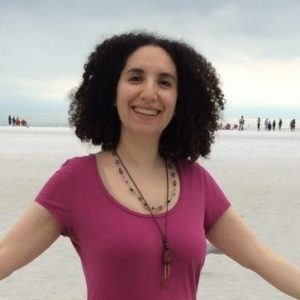
Playful. Embodied. Activist. Empowering. Feminist. Fresh. In recent years, there has been a wave of new creative writing for Jewish holidays: liturgy, poems and songs that help us connect to the themes of the holidays and both renew and transform traditional texts and ideas. We will explore one holiday per course session, with Tisha B’Av as the focus for the third day. In each session, we will reflect on our relationship with the selected Jewish holiday, explore contemporary poetry and songs for the holiday, and write our own creative additions to the tradition.
- Contemporary Issues
- Religious Life and Spirituality
- Suited for Teens
Tisha B’Av: Reflecting, exploring, singing and writing for Tisha B’Av.
Ilana Joy Streit is a Hebrew priestess, singer/songwriter, and lover of life. She writes interpretive Jewish liturgy, including blessings for Hebrew months. Ilana teaches creative and embodied approaches to Hebrew and Jewish holidays, and coaches Jewish leaders and seekers in living healthy, balanced, Jewishly empowered lives. A longtime havurahnik, Ilana has previously taught Melody as Midrash and Creative Relationship to Shabbat. Ilana has studied and practiced various movement forms and healing modalities, including chi gung, Nia and the Feldenkrais method. She lives in the Boston area and spends a lot of time singing and listening to music.
AM-13: How to Design a Synagogue Space in 10 Culturally Appropriative Steps, Raysh Weiss
Come take a whirlwind tour across the globe and through time as we explore the art and architecture of the synagogue as it has evolved throughout the Jewish diaspora and its implications for how we understand community. We will consider how Jewish communities’ interaction with their surroundings result in dynamic encounter and exchange, which characterizes Jewish cultural heritage in the myriad communities Jews have lived around the world during the past two millennia. Jewish art is about Jewish life in far flung lands and what they retained as they adapted to new cultural environments. Given the multiplicity and diversity of the synagogues, we will limit our focus to ten synagogues, each of which exemplify a particular time and place. We will consider their “journey” from when they were built to the present – thinking about memory and identity – if they still exist, what are these synagogues today – how are they used – are they still active synagogues, places of memory, museums – repurposed for another place of worship or for some other function? Together, we’ll consider the evolution of the aesthetics of Jewish worship spaces around the world and how these aesthetic decisions inform each space’s function, communal identity, and purpose.
- Arts, Music, Performance
- Contemporary Issues
- History and Culture
Tisha B’Av: Entering modernity.
Raysh is a member of three shuls (and the rabbi of one of them). Previously, Raysh served communities in Nova Scotia, Long Island, Brooklyn, and Tel Aviv and also founded a havurah in Minneapolis. Raysh also holds a PhD in Cultural Studies and Comparative Literature and is passionate about promoting widespread Jewish literacy. This is Raysh’s fifth Institute.
Afternoon Courses
PM-1: Breathing New Life: Chassidish & Original Nigunim for Transformations, Rena Branson
Through this course, sacred song and silence will guide us beyond our everyday mental chatter and return us to ourselves and to each other in the present moment. We’ll open the sessions with a contemporary melody and then dive into esoteric nigunim (melodies) of the Chabad Chassidish tradition. ChaBaD, or חב”ד, is an acronym for Chochma—the seedling of bright wisdom, Binah—taking root in deeper understanding, and Da’at—intimate knowledge that bears fruit in practice. Chabad nigunim are often acrobatic exercises that help refine our souls to do their holy, courageous tasks on earth. We’ll cultivate focus, patience, perseverance, and compassion as we stretch to let these complex nigunim blossom through us, and feel ourselves blossoming through them. On Tisha B’Av, we’ll also hold space for silent meditation and an optional invitation to share reflections. All voices are welcome.
- Arts, Music, Performance
- Meditation and Movement
- Religious Life and Spirituality
- Suited for Teens
Tisha B’Av: Silent meditation and reflection, discussion, and singing of mournful melodies.
Rena Branson is an educator, musician, and prayer leader. Through a labyrinth of circumstances, she met her Chassidish father for the first time in 2014 and discovered her love for singing traditional nigunim (sacred melodies) together. She now works to make Chassidish nigunim more widely accessible and share their healing power in progressive Jewish communities, teaching workshops and private lessons. She founded A Queer Nigun Project, which hosts monthly nigun singing at Jewish services in jails as well as events for LGBTQIA+ folks in New York and Philadelphia. She spent the past year studying Jewish music full-time with Joey Weisenberg in the Rising Song Residency and has facilitated programs at Let My People Sing! and Hadar’s Rising Song Intensive. Her recordings of traditional nigunim and original tunes for liturgy are available online.
PM-2: An Ensemble of Lamentations: Devised Material/Physical Theater on Megillat Eicha, Yavni Bar-Yam
André Gregory reported that Antonin Artaud said: Works of theater should be created in three years or in three days. In this course, we are going to take the latter route, rapidly getting our bodies, minds and hearts into a passage from Eicha/Lamentations, and using a process of collaboratively devised physical and material theater to illuminate different perspectives and motives in the text. We will work with materials and our own physicalities in unconventional ways, transforming objects into characters, for example, and ourselves into objects. We will work in small subgroups, to make mini experimental theater pieces on different aspects of the same passage, and then we will combine them together into a unified theatrical experience, (potentially) to be presented to the rest of the community.
- Arts, Music, Performance
- Suited for Teens
Tisha B’Av: Continued development of theatrical treatment of Eicha/Lamentations.
Yavni is a puppeteer, which means he doesn’t have to choose between being a performing, visual, and literary artist. He has performed traditional Italian masked comedy in Bangkok, Czech revolutionary theater in New York, and street clowning in Israel. He has devised rod puppetry accompaniments to contemporary classical song cycles, built large-scale parade puppets for Ashkenaz Festival Parade 2018 and created video found-object-puppetry-of-the-absurd as part of Hermit Appendage. He was the 2016 Timbrel Artist in Residence at NHC Summer Institute, where he was fortunate to work with the best company of wilderness shadow puppeteers.
PM-3: Tending to the “Haver” in Havurah: Fostering Friendships with a Jewish Lens, Miriam Rosalyn Diamond
The word HaVuRah literally has “friend” (HaVeR) at its root. Friendship has always been valued in Jewish culture. Through individual reflective exercises, paired/hevruta study and small group discussion, participants will explore a variety of commentaries, controversies, poetry and song – traditional and modern – that provide direction for fostering positive friendships. We will consider questions such as: What do donkeys have to do with friendship? When should you avoid eating with a friend? How do you greet a friend after a long separation? Should you sit shiva for friends? We will compare these with contemporary social science theory and reflect on implications for our own friendships. In this season of Tisha B’Av, we will consider what Judaism has to say about friendship, loss, and consolation. The class will culminate with the opportunity to draw upon a variety of media (art, role play, poetry, song) to create midrashim (interpretive stories) on key biblical Jewish friendships. This class is ideal for anyone interested in examining and grappling with ancient as well as contemporary thought on friendship.
- Text Study for Everyone
- Arts, Music, Performance
Tisha B’Av: Torah study on friendship, loss, and consolation.
Miriam Rosalyn Diamond, PhD, developed and taught a college course on The Psychology of Friendship, and studies mattering as well as the intersection between faith and these key relationships. An inclusive educator, she enjoys leading highly interactive sessions that foster personal meaning for participants, integrating techniques such as hevruta/paired study, individual reflection, and the arts.
PM-4: The Story of Joseph in Jewish Tradition: More Than A Technicolor Dreamcoat, Jonathan Harold Dine
The story of Joseph and his brothers is one of the longest sustained narratives in the bible and is famous for its narrative structure. One scholar called it “one of the greatest works of biblical narrative prose,” and it is often referred to as a novella: Sibling rivalries! Cliffhangers! Hidden identities! Climactic reveals! In this class, we will explore how the rabbis and the creators of our prayers (through intertextuality and other Rabbinic methods of reading that we will explore together) transformed the Joseph story into something much larger: a ‘myth’, a narrative which creates meaning for all of its inheritors beyond the story’s own literary features. While all texts will be provided in translation, participants will be expected to have some prior experience with the siddur (prayer book) and at least some familiarity with how the rabbis interpret biblical texts.
- Religious Life and Spirituality
- Intermediate Text Study
- Advanced Text Study
Tisha B’Av: Deep dive into Eleh Ezkera, the martyrology recited on Yom Kippur and also on Tisha B’Av in some Sephardic communities, and how it frames the story of Joseph’s sale into slavery.
Jon Dine currently works as a data analyst/scientist for Booz Allen Hamilton in Washington DC. Outside of work he is an active participant and former Steering Committee member at DC Minyan in downtown DC. He is a proud alumnus of the University of Chicago, where he took numerous Jewish Studies courses. Jon has also studied at the Pardes Institute for Jewish Studies in Jerusalem, was a fellow at Yeshivat Hadar in New York, and was a Zeitler fellow in 2014.
PM-5: Accessing our Core Divinity, Martha Louise Hare
“Where is G‑d? Wherever G-d is allowed in.” (Kotzker Rebbe). Access to our divine nature and its reflection in the other allows us to be more effective during times of upheaval. In contemporary society, many people are cut off from exploring this possibility because of generations of “baggage” surrounding notions of God or godliness. The course is open to seekers of all kinds – those who are mainly comfortable in a Jewish idiom, those who are profoundly skeptical of divinity, and those whose explorations have included ventures outside of Judaism to name a few. The course seeks to assist the learner in developing a Jewish idiom for this very personal experience. Safety of expression will be paramount. Each session will begin and end with breathwork and meditation, with time for gentle movement. Core texts on encountering the divine will evoke discussion. Learners will be encouraged to engage with each thinker on an experiential level. Journaling (prose, poetry, art) will deepen experience. It is possible that learners will have an “aha” moment, but far more important is increasing confidence in continuing the search for divinity in ourselves and in others
- Meditation and Movement
- Religious Life and Spirituality
- Text Study for Everyone
Tisha B’Av: Where is God? 20th century theologians.
Martha has a great love of both yoga and Yiddishkeit. Formally trained in anthropology and in nursing, she has spent the year after retirement focused on building her skills as a yoga instructor and in her studies of Jewish Spirituality with a concentration on Spiritual Direction as a modality for addressing spiritual and historical trauma. Also, as an activist Martha has found that grounding in a deeply felt sense of divinity is crucial for coping with the challenges of our time. Here, she seeks to further co-create with learners a Jewish approach to the experience of Divinity.
PM-6: Probing and Parsing the Language of the Shacharit (Morning) Service, Ronnie Levin
The siddur (prayerbook) is an anthology and not all of its contributing writers have agreed with each other. The language of the b’rachot (blessings) associated with the Sh’ma are the key to the structure, themes and motifs of the morning service – as they have evolved inconsistently over millennia. We will also compare the structure and translations of different siddurim. Translations are interpretations! This is a deep dive into the text. The better you know the material, the more depth you will see.
- Text Study for Everyone
- Intermediate Text Study
- Advanced Text Study
Tisha B’Av: Ahavah rabbah, “a great love”, the second blessing before the Sh’ma.
Ronnie Levin holds a graduate degree in Bible and tefilah and has been a popular Havurah teacher for many years. In “real life,” Ronnie recently retired after 37+ years as a scientist at the Environmental Protection Agency and now manages the Water and Health Program at the Harvard School of Public Health.
PM-7: The Grammar of Torah Reading, Adam Simon Levine
The te’amim / trop / cantillation marks that are used for chanting Torah, Haftarah, and Megillot are more than just musical notes; they are an intricate system of punctuation that is closely tied to the syntax and meaning of the text. In this course, we will dive deep into the workings of this system. We’ll see how the te’amim can offer insights into the interpretation of a text and how they can (sometimes) be deduced from the text’s sentence structure. We’ll also learn about the history of cantillation and the surrounding laws and customs. (Note: This is not an introductory Torah reading course; it will assume basic Hebrew comprehension and familiarity with the te’amim.)
- Advanced Text Study
Tisha B’Av: Verses explored will all be taken from Eicha/Lamentations.
Adam Levine is an assistant professor of mathematics at Duke University, where he studies topology, the classification of the shapes of knots, surfaces, and their higher-dimensional analogues. He has been attending Institute since 2009 and was on the NHC board for six years. He is an avid fan of bad puns, complicated crossword puzzles, and the New York Yankees.
PM-8: What Would Mordecai Kaplan Do? Study William James!, Ethan M. Merlin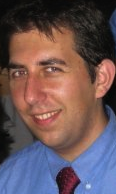
In 1915, Mordecai Kaplan, founder of Reconstructionist Judaism, gathered a group of rabbinical students in his home on Saturday nights to study the writings of American psychologist and philosopher William James. More than 100 years later, we’ll carry on this tradition by gathering to read James in a Jewish context at the Summer Institute. James redefined religious belief in an age of science by focusing on the practical consequences of what we choose to believe. How did Kaplan and his early twentieth-century “havurah” apply James’s ideas in their reconstruction of Judaism? And what do we have to learn today from James’s “Torah”?
- Religious Life and Spirituality
Tisha B’Av: James’s Influence on Kaplan.
Ethan has been attending NHC Institutes since 2000. He and his family live in Silver Spring, MD, and they participate regularly in two grassroots Jewish communities (Tikkun Leil Shabbat and Minyan Segulah) in the DC area. Ethan teaches middle school math (since 2002), and he studied Comparative Religion in college (where he wrote his senior thesis on the thought of William James and Mordecai Kaplan).
PM-9: Great Big Love: Why Ahavah Rabbah is the Most Common and Perhaps Greatest Jewish Musical Mode, Louis Polisson
What is the name of the musical scale used by cantors on Shabbat morning in your local Ashkenazi synagogues? What does it have in common with “Havah Nagilah,” a song that you’ve probably heard at B’nei Mitzvah, other Jewish celebrations, or even some sporting events? What does any of this have to do with love? Come learn about and sing what is perhaps the greatest Jewish musical mode: Ahavah Rabbah (“Great Love”), known in klezmer circles as Freygish and American music theory as Phrygian dominant. We’ll learn the mode itself. We’ll learn a bit about its history and uses in various musical traditions. And finally, and most importantly, we’ll learn and sing many different melodies that use this mode, from klezmer tunes to Jewish liturgical compositions to recently composed niggunim (wordless melodies) to Dick Dale and the Black Eyed Peas.
- Arts, Music, Performance
- Contemporary Issues
- Religious Life and Spirituality
Tisha B’Av: How, when, and where Ahavah Rabbah mode is used in traditional Ashkenazi nusah tefillah (prayer melody that varies by time of day and occasion).
Louis Polisson serves as rabbi of Congregation Or Atid of Wayland, Massachusetts. He earned rabbinic ordination and an MA in Jewish Thought from JTS in 2018. Louis studies, composes, and performs music of all kinds, from hardcore punk to klezmer. He has studied Jewish music with Cantor George Mordecai, Joey Weisenberg, Alicia Svigals, Rabbi Greg Wall, Aaron Alexander, and David Chevan, among others. Louis has worked as a songleader and educator in a wide variety of Jewish settings in the New England and New York areas such as the URJ Eisner Camp in Western Massachusetts, B’nai Jeshurun in NYC, and the Isabella Freedman Jewish Retreat Center in Connecticut. Supported by a Hadar Alumni Micro-Grant, Louis and his wife Gabriella Feingold released a CD of original Jewish and folk music in November 2018, titled “As Full of Song as the Sea.”
PM-10: A Close Reading of B’tzelem Elohim (In the Image of God): Biblical Text and Disability Studies, Ora Horn Prouser
“Hafoch bah v’hfoch bah d’chulei bah – Turn it over and over for everything is in it” (Pirkei Avot/Ethics of Our Fathers 5:26). Each time we view the Bible through a new lens, we add to our understanding of the text, we learn more about ourselves, and we widen the impact of the Bible on the Jewish community. Through close readings, in this course, we will approach the biblical text through the lens of disability studies. We will see how viewing certain biblical personalities through this lens provides access to new dimensions of their characters and the texts in which we encounter them. We will then consider the character of God in the Bible and how God too can be more deeply appreciated through the perspective of disability studies. This analysis challenges us to broaden our understanding of the concept of b’tzelem Elohim (in the image of God) and will help us in the critical work of more fully appreciating the image of God in those with physical, emotional, and intellectual disabilities.
- Contemporary Issues
- Religious Life and Spirituality
- Text Study for Everyone
Tisha B’Av: Torah study exploring the idea of God having physical disabilities.
Ora Horn Prouser, Ph.D., is the CEO and Academic Dean at The Academy for Jewish Religion, a pluralistic rabbinical, cantorial and graduate school in Yonkers, New York. She has also worked with the Melton Center for Jewish Education, the Davidson School of Education at JTS, and various educational institutions to develop curricula and approaches to Bible pedagogy for all levels and learning styles. Her book, Esau’s Blessing: How the Bible Embraces Those with Special Needs was recognized as a 2012 National Jewish Book Council finalist and as a Gold winner in the 2016 Special Needs Book Awards.
PM-11: Patriarchy-Smashing in the Book of Judges, Jonah Rank
The Book of Judges portrays a nearly anarchic Israelite civilization grappling with shifting cultural norms. In super-short stories and a few several-chapter-long adventures, Judges anthologizes narratives that are connected, not by continuity of characters, but by sharing similar themes. Bubbling beneath the surface of this biblical book is an anxiety over what roles men–especially fathers–should play in society. Although certain chapters in Judges offer obvious critiques of the way gender and families were structured in ancient Israelite life and memory, certain stories are only subtle in expressing their disapproval of new and old societal norms. In this course, using contemporary as well as classical (and some mystical) rabbinic commentary, we’ll examine a few selections from Judges that most clearly illustrate how an evolving early civilization began to form and to reform its sense of civility.
- Contemporary Issues
- Religious Life and Spirituality
- Intermediate Text Study
Tisha B’Av: Judges, Chapters 6, 7, 8 and 11.
Jonah serves as the Director of the Shul School at Kehilat HaNahar in New Hope, PA. Jonah’s MA in Jewish Thought comes from the Jewish Theological Seminary, where Jonah was ordained in 2015. An award-winning Jewish songwriter, Jonah studied Music at Columbia and Jewish Music at JTS as an undergrad. For four summers, Jonah created pluralistic Jewish artistic spaces in Waltham, MA, at BIMA. Jonah writes and edits for Jewish educational, academic, and liturgical projects—including Siddur Kanfey HaShekhinah, a forthcoming (mostly) traditional Ashkenazic Hebrew prayer-book where the references to God are (almost) entirely feminine.
PM-12: Chemical Hazards: A Jewish Perspective on a Challenge for Labor and Environmental Justice, Darius D. Sivin
In the United States, it has been estimated that there are approximately 49,000 annual deaths due to work-related illnesses; worldwide, there are approximately 1,170,000. Outside the workplace, chemical hazards are a major example of environmental injustice by race and class, with people of color almost twice as likely as whites to live near dangerous chemical facilities. The poverty rate among those living closest to hazardous facilities is 50% higher than for the U.S. as a whole. Looking at Rabbinic texts on occupational hazards, the history of Jewish involvement in American struggles for occupational health, and relationships between worker and environmental justice concerns, this course will provide a Jewish perspective on both and will facilitate involvement in advocacy around these issues.
- Contemporary Issues
- Text Study for Everyone
Tisha B’Av: Study of passages from Aicha (Lamentations), accounts of living with chemically-related diseases and/or in areas affected by environmental injustice.
Darius Sivin is an occupational health and safety professional for the United Auto Workers and a member of various havurah minyanim since 1986. He has taught one class and many workshops at Institute and he has taught Jewish topics to adults and children at Fabrangen Cheder, Fabrangen Chavurah, Shirat Hanefesh and Washington DC’s Jewish Study Center.
PM-13: Niddah Salon: Engaging with Rabbinic Texts about Menstruation, Miriam-Simma Walfish
The niddah salon is an opportunity for us to bring our full selves to the study of the laws of niddah, the practice of refraining from sexual intimacy around the menstrual cycle. While these laws have often been read as a way of objectifying women’s bodies, more recently Jews of all stripes have been reclaiming them and have found the cyclical nature of these laws helpful. In this niddah salon we will acknowledge that different aspects of these laws can strike each of us in different ways. The hope of this class is that when we come together to explore these texts, without assuming that either the texts provide a simple framework for practice, or that they are archaic records of a patriarchal society, the encounter will transform both the text and, potentially, our own experience of our bodies. This course is open to people of all genders of any sexual orientation or relationship status.
- Religious Life and Spirituality
- Text Study for Everyone
- Suited for Teens
Tisha B’Av: Consideration of the concept of distancing from intimacy, without direct Torah study.
Miriam-Simma Walfish is a Jewish educator based in Boston. She has taught in numerous settings including Harvard University, Mayyim Hayyim, Yeshivat Hadar, and the NHC Summer Institute. She loves the process of making meaning of Jewish texts with havrutot and students. She is excited to be attending Institute this year with her children Nechama and Adira.






